Just last year, Stuart Benjamin signed a 10-year lease in a building near a high-traffic mall in San Diego and began creating the jewelry store of his dreams. In the spring of this year, he was ready to open.
“I got everything up and running and the merchandise in the cases on March 16,” he says. “We finally put the open sign up, right? And then on March 17, the governor closed us down. I came in and told everyone, ‘Sorry, you’re all on unemployment.’”
He’d thought of everything. But he couldn’t have anticipated a pandemic. “It was kind of heartbreaking,” Benjamin says.
While many chain and mall stores in his market stayed closed through the summer following shutdowns for the COVID-19 pandemic, bridal was Benjamin’s road back into business when he reopened on June 6. About 90 percent of sales were wedding related. “People who put off the weddings or put off the rings, the guy wants to get them now,” he says.
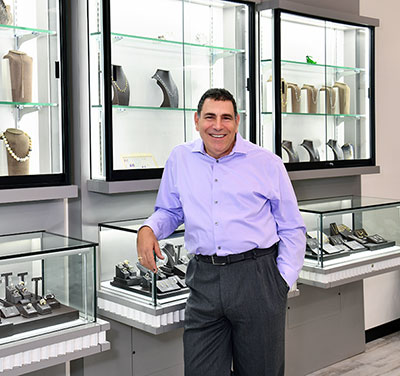
Stuart Benjamin opened a new location in San Diego in March.
Consumers aren’t window shopping; they’re motivated to buy. Although that means less foot traffic and fewer browsers, it also means that local jewelers have been pre-shopped online, and customers show up knowing what they want.
One customer, for example, drove 170 miles from Indianapolis to Eileen Eichhorn’s store, Eichhorn Jewelry in Decatur, IL, with a picture of a ring he’d seen on the website of an Indianapolis store that wasn’t open. “He was here five, 10 minutes,” Eichhorn says. “I worked on a sketch while he went out for coffee. Then he called me and said, ‘I think you know what I like.’ And that was it.” He put a deposit down and the deal was closed.
Summer demand and shortages were enough to push the wholesale price of 1-carat and half-carat round diamonds up 2 percent, according to Edahn Golan, a diamond analyst based in Israel. “This demand comes from consumers who understand that COVID-19 is a long-haul thing,” he says.
Advertisement
Weddings are shrinking, but few engaged couples want to skip the ring. “People will cut back on the number of guests, the band, the DJ, the venue and the flowers. They are not cutting back on the jewelry,” Golan says.
Research says people want fewer, better things, much like they did during the Great Recession. Says Golan: “There is something about jewelry that works very well in economic duress.”
In Denver, Kaeleigh Testwuide of The Diamond Reserve says her clients, with an average age of 30, have typical budgets of $15,000 to $20,000 that have not yet been reduced by pandemic concerns. Two carats is the desired center-stone size, and June sales set new records for her appointment-only business. “The demands of this generation are setting the bar very high,” says Testwuide, whose experience belies the once prevailing assumption that millennials don’t want expensive jewelry. In fact, according to The Knot 2019 Jewelry & Engagement Study, 47 percent of engagement rings have a center stone between 1 and 2 carats, while 22 percent are larger than 2 carats.
Appointments, in person, and virtual, have served her well, allowing for a personal experience. “If you’re working by appointment only, it’s important to stick to that plan,” Testwuide cautions. “If someone walks in without an appointment, ask them to come back. It drives home the idea that you’re in demand.”
Andrea Hill of Hill Management Group says if the economy contracts again, people are going to get scared and focus only on what they need, which will lead to a new phase of conservative consumer behavior. “Because consumer behavior is likely to become more conservative and stay conservative for some time, engagement rings are likely to be one of the few necessities in jewelry for a while.”

Get the Word Out
“I got everything up and running and the merchandise in the cases on March 16,” he says. “We finally put the open sign up, right? And then on March 17, the governor closed us down. I came in and told everyone, ‘Sorry, you’re all on unemployment.’”
He’d thought of everything. But he couldn’t have anticipated a pandemic. “It was kind of heartbreaking,” Benjamin says.
While many chain and mall stores in his market stayed closed through the summer following shutdowns for the COVID-19 pandemic, bridal was Benjamin’s road back into business when he reopened on June 6. About 90 percent of sales were wedding related. “People who put off the weddings or put off the rings, the guy wants to get them now,” he says.
Consumers aren’t window shopping; they’re motivated to buy. Although that means less foot traffic and fewer browsers, it also means that local jewelers have been pre-shopped online, and customers show up knowing what they want.
One customer, for example, drove 170 miles from Indianapolis to Eileen Eichhorn’s store, Eichhorn Jewelry in Decatur, IL, with a picture of a ring he’d seen on the website of an Indianapolis store that wasn’t open. “He was here five, 10 minutes,” Eichhorn says. “I worked on a sketch while he went out for coffee. Then he called me and said, ‘I think you know what I like.’ And that was it.” He put a deposit down and the deal was closed.
Summer demand and shortages were enough to push the wholesale price of 1-carat and half-carat round diamonds up 2 percent, according to Edahn Golan, a diamond analyst based in Israel. “This demand comes from consumers who understand that COVID-19 is a long-haul thing,” he says.
Weddings are shrinking, but few engaged couples want to skip the ring. “People will cut back on the number of guests, the band, the DJ, the venue and the flowers. They are not cutting back on the jewelry,” Golan says.
Research says people want fewer, better things, much like they did during the Great Recession. Says Golan: “There is something about jewelry that works very well in economic duress.”
In Denver, Kaeleigh Testwuide of The Diamond Reserve says her clients, with an average age of 30, have typical budgets of $15,000 to $20,000 that have not yet been reduced by pandemic concerns. Two carats is the desired center-stone size, and June sales set new records for her appointment-only business. “The demands of this generation are setting the bar very high,” says Testwuide, whose experience belies the once prevailing assumption that millennials don’t want expensive jewelry. In fact, according to The Knot 2019 Jewelry & Engagement Study, 47 percent of engagement rings have a center stone between 1 and 2 carats, while 22 percent are larger than 2 carats.
Appointments, in person, and virtual, have served her well, allowing for a personal experience. “If you’re working by appointment only, it’s important to stick to that plan,” Testwuide cautions. “If someone walks in without an appointment, ask them to come back. It drives home the idea that you’re in demand.”
Andrea Hill of Hill Management Group says if the economy contracts again, people are going to get scared and focus only on what they need, which will lead to a new phase of conservative consumer behavior. “Because consumer behavior is likely to become more conservative and stay conservative for some time, engagement rings are likely to be one of the few necessities in jewelry for a while.”
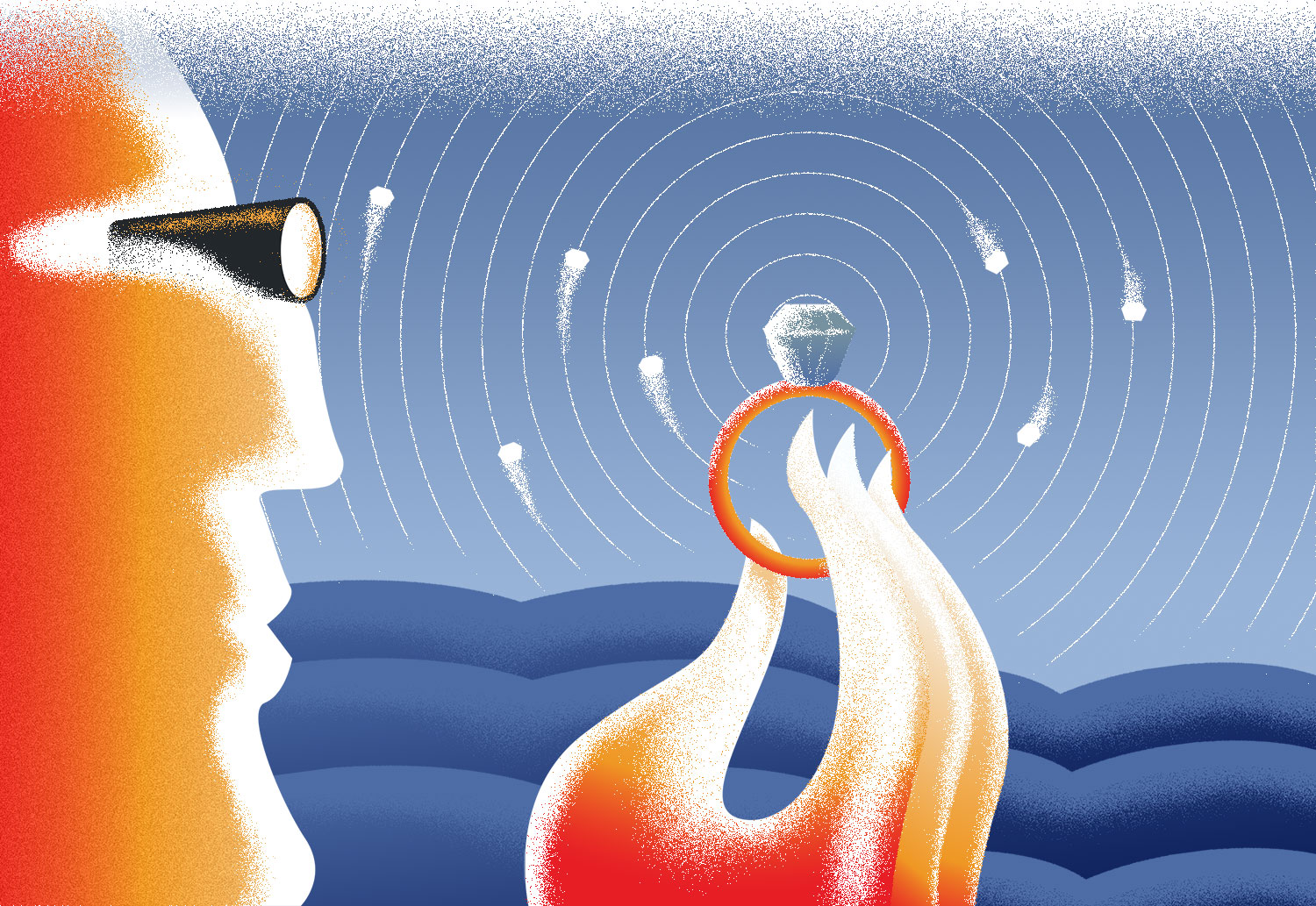
Analyze Your Inventory
If your business model isn’t bridal-oriented, consider adding a slimmed down or custom bridal option, suggests consultant Kathleen Cutler. “It’s a great way to get clients to walk in your door. Where an engagement ring is concerned, usually they want it now. And then you have that opportunity to keep in touch with them over a lifetime.”
When it comes to diamonds, make sure you stock what you need or can get it quickly, says Michael Indelicato, CEO of RDI Diamonds. “Sell yourself. If you’re selling paper when it comes to diamonds, you’re saying you’re not that great at what you do. The best of the best don’t even talk about lab reports. Bring out the best product for their budget and ask them what shape they want.”
Round brilliant cut diamonds are consistently the most popular and will always be in high demand. Currently, ovals are popular, too. Nationally, Indelicato is seeing buying patterns of SI1, SI2 and I1s with colors ranging from F to J. Carry the bread and butter basics, which, in a lot of areas, are half and three-quarter carat diamonds. But have 1 carat diamonds on hand, too. “Eighty percent of engagement ring shoppers buy a ring on the first day they set out to shop for one,” he says. “If you don’t have what they want, they will go somewhere else.”
Have fast sellers on hand and aim for at least a one-time stock turn on bridal. “Focus on your data and the industry’s data,” says Sherry Smith of the Edge Retail Academy. “Review the last 12 to 13 months, because 20 percent of your stock is driving 80 percent of your revenue. Review the past year’s bridal sales and identify your fast-selling semi-mounts to make sure you have those in appropriate size rings and appropriate size heads.
Advertisement
Fast sellers are fast sellers. Get it back in. If you have a finite number of items that are selling well, you don’t want to be out of those.”
Adwar of Brooklyn Jewelers suggests retailers work with suppliers to offer their own signature collections that can’t be shopped anywhere else. “The days of huge inventory are gone,” he says. “Stores are the brand now.
Retailers have done all that heavy lifting in building relationships. We’re picking select retailers, one per region, because I don’t want everyone to have the same stuff. We have retailers that carry a small selection of our stuff, and then they order from there. We have a state-of-the-art CAD facility and we can make those adjustments on the fly.”
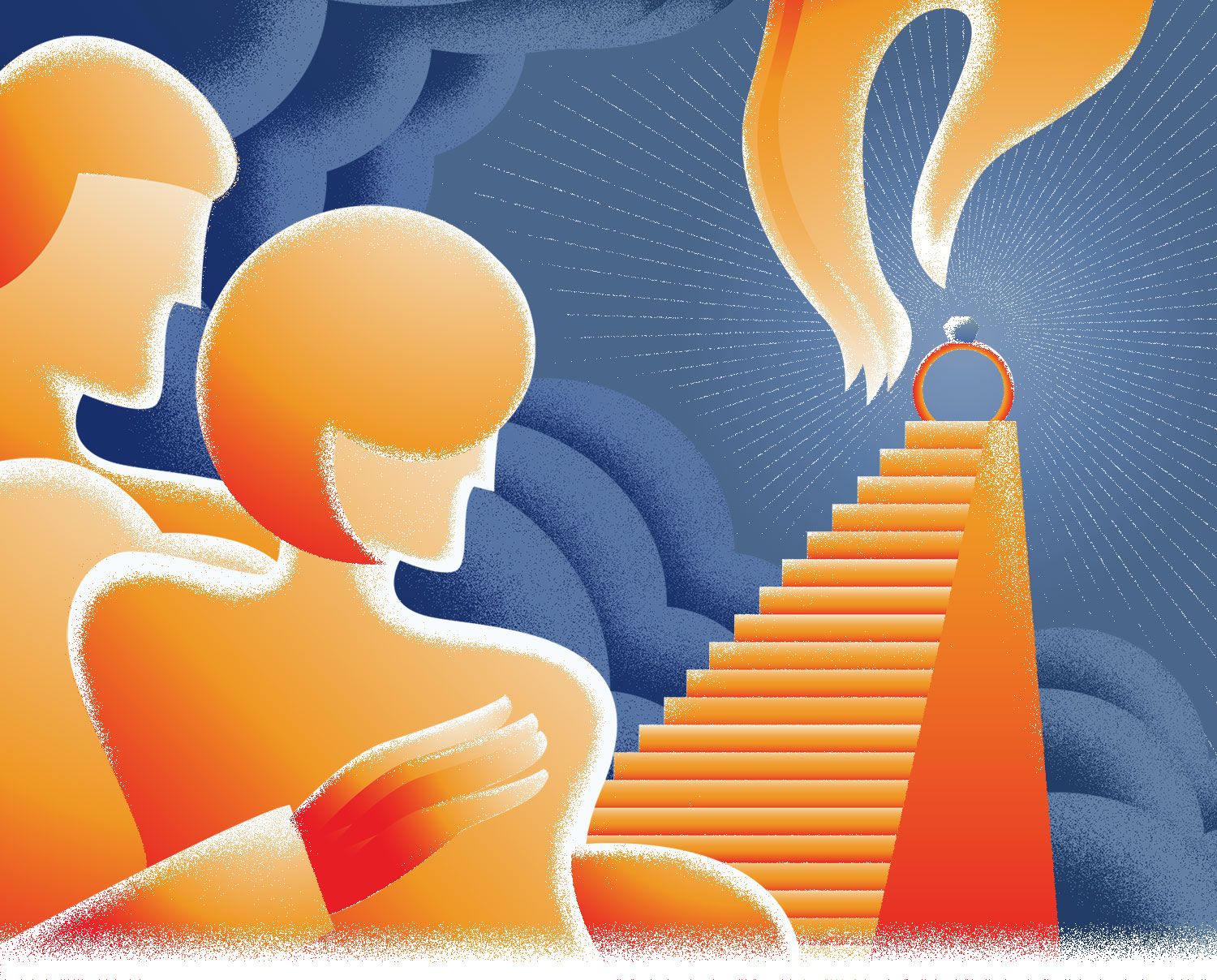
Fine-Tune the Shopping Experience
At Iowa Diamond, customers are comfortable visiting Chuck Kuba’s appointment-only business on the second floor of an office building. Kuba and team wear masks, scrub every surface and sanitize jewelry and trays after every customer. “No one has complained or refused to wear a mask,” Kuba says. “We sit across a desk, so we are 4-and-a-half or 5 feet apart. Nobody is yelling. Nobody is coughing.” Kuba’s customers, too, are thinking big, shooting for a carat-and-a-third or a carat-and-a-half with an average budget around $7,500.
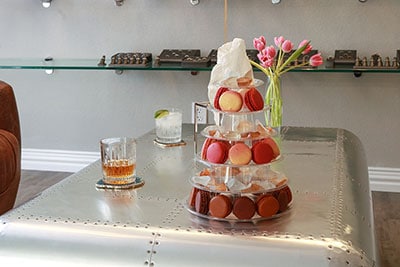
Diamond Date Night at the Diamond Room in Dallas is all about romance.
Gabrielle Grazi, VP of retail strategy for the Natural Diamond Council, says that with sales staff’s smiles hidden behind masks and a concentration on cleaning, it’s a time when soft skills, or relationship-building, are more critical than ever. “An engagement is such a special time, and to have all of this going on in the background when you are thinking about your future and trying to plan a wedding and move your life forward, is hard.” So rather than a “salesy approach,” offer an authentic experience and make sure your sales team is operating with high emotional intelligence. “You never know what’s happening in customers’ lives. We all have to be kind with one another.”
Andrea Hill says that Gen Z and millennials are not in love with the typical engagement ring buying experience to begin with. “It requires couples to spend a lot of time in the store looking at a lot of diamonds and mountings, then return to see diamonds that have been brought in from dealers on memo, then return again to pick up the final piece (with a possible fourth visit tucked in there somewhere).” Clients in the age of COVID-19 may not want to have that much exposure to the store.
“We get very caught up in the idea that customers want to have the diamond experience, but in fact, customers are willing to buy diamonds, particularly those in the three-quarter to 2-carat range, without going through a lot of in-store selection activity,” Hill says. Stores that have an excellent selection of preset rings, ready to sell, or size and sell, will be in a position to capture that demand.
When clients do come into the store, make sure they know what to expect, Hill advises. Tell them, “I know some people are trying to limit their time spent indoors in public spaces. The engagement ring experience typically takes X-Y hours. What length of appointment are you comfortable with? And would you like to do some of this work via a video call, so we can prepare as much as possible prior to your visit?”
Make sure you have a seating setup that ensures comfort for people who are more aware than ever of maintaining personal space. Counters and tables between people can be off-putting and plexiglass awkward. Look for ways to create seating that naturally keeps people at a comfortable distance from one another. For instance, a low, wide coffee table with chairs on either side can lower barriers while gently reinforcing the need for distance, Hill suggests.
Despite precautions, it is still possible to create a special experience. For Diamond Date Night at The Diamond Room in Dallas, for example, owner Matthew O’Desky has designed a romantic evening that remains viable in COVID-19 times. Clients enter through a bank building and walk into a fully stocked bar area. From there, sliding showroom doors open to reveal the sleekly modern space. As part of the engagement process, the prospective groom can surprise his beloved with a private evening catered with their choice of cocktails, music, hors d’oeuvres, flowers and desserts, during which they can also look at a large selection of diamonds and together design their dream ring.
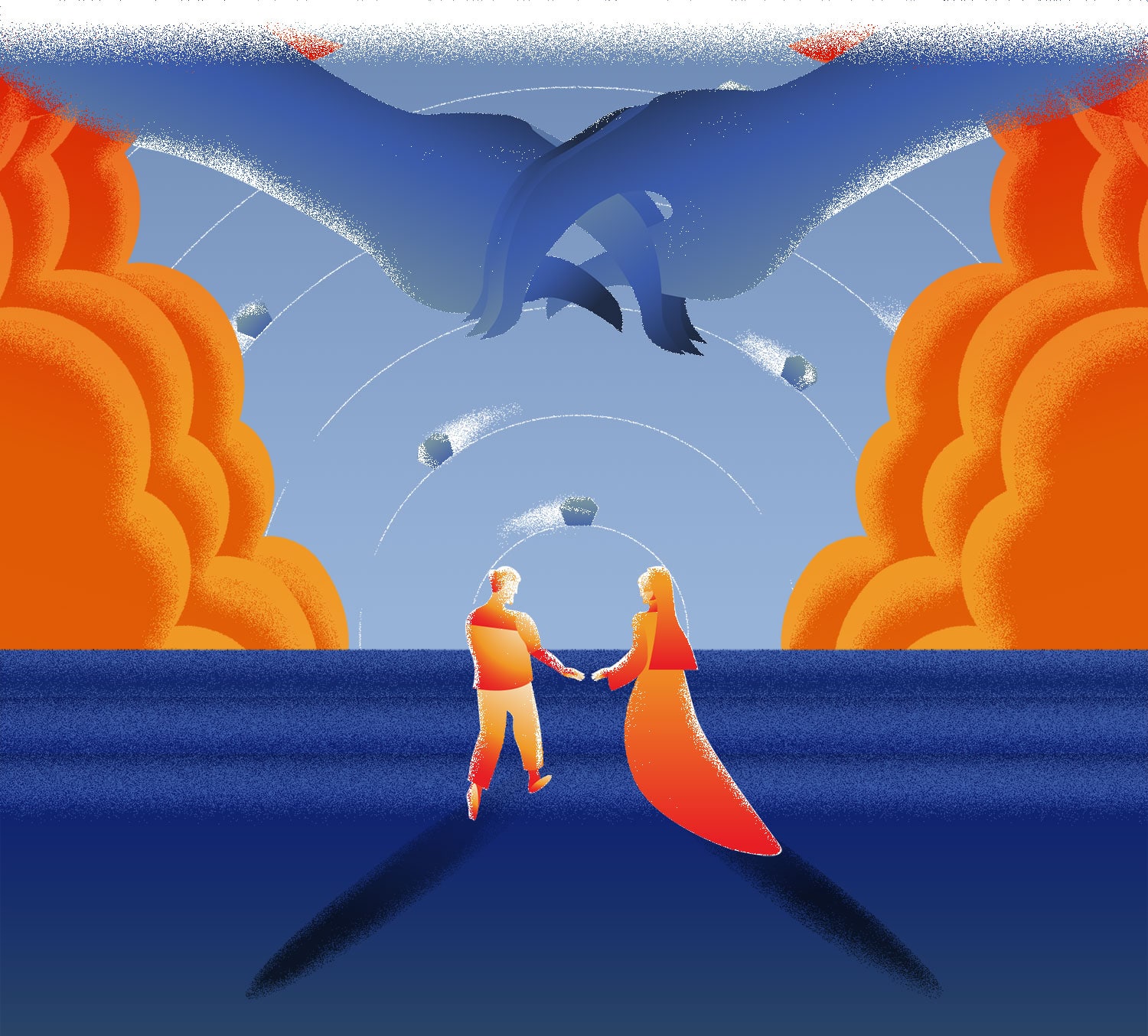
Engagement Is Just the Beginning of the Story
People will keep wanting to be close to those they love, and I see engagement being a steady, steady sale,” says Kathleen Cutler. “And it’s not a one-off sale; it’s really the beginning of the story. You can become their jeweler for life.”
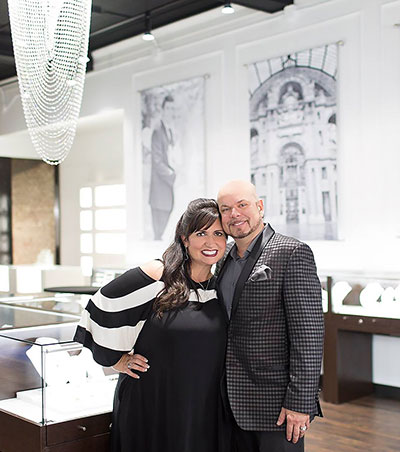
Sherri and Randy Erickson go far in bridal sales simply by being nice.
Begin that relationship with a gift, suggests Smith of The Edge Retail Academy. If the groom comes in alone to pick up the engagement ring, encourage him to return with his betrothed so that you can present her with a bridal gift bag, make sure the ring is a perfect fit and establish rapport. The bridal bag should include a piece of promotional fine jewelry, such as a pearl necklace, branded jewelry cleaner and an incentive gift certificate toward the purchase of wedding bands.
Make it simple for them to return, too, by hosting virtual wedding band events, Smith says. Pull a list of your last six months of engagement ring customers and decide if you want them all to attend at once, divide them into groups or work with them one on one.
Hill encourages clients to make sure they have enough modern, exciting wedding-band styles for women, since some couples don’t want to spend money on both an engagement ring and bands right now. “At my company, we monitor online search behavior, and we’ve seen an uptick in queries like, ‘Do I have to wear both an engagement ring and a wedding band?’” Hill says. “This could indicate a style shift, or it could be an anomaly, but it’s possible that younger people who are interested in getting married are also concerned about how healthy their personal economies will be over the next few years. So it would be a good idea for retailers to do more promotion around standout wedding bands that can do double duty.”
Cutler suggests retailers look not only to new bridal business, but also reach out to customers who may want to upgrade. “Your existing clients are the people who are most likely to buy from you and trust you enough to do a virtual appointment or come into your store,” she says.
Advertisement
Sherri Erickson of Erickson Jewelers in Iron Mountain, MI, strives to offer something for everyone as a way to build relationships. “In our area, we don’t have a JC Penney, and Walmart took out their jewelry counter,” she says. “So it’s us and two other jewelry stores. I don’t want people to come in and feel they can’t afford anything. I have a nice selection of $10,000 rings, but I also have some rings they can buy for $100. I want them to come back some day and I want them to tell their friends we were nice to them even though they were only spending $100.
“I hear from younger people who thank us for being so nice to them,” she says. “Most people who come in have pictures of things they saw online. If they’re not treated well, they’ll say, ‘Screw it. I’m going to buy it online.’ I want them to be happy and to have a beautiful piece of jewelry because that makes me happy.”